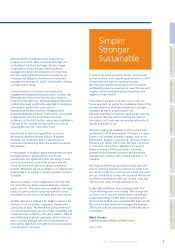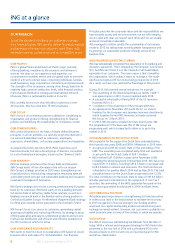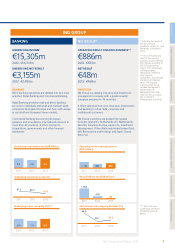ING Direct 2013 Annual Report Download - page 17
Download and view the complete annual report
Please find page 17 of the 2013 ING Direct annual report below. You can navigate through the pages in the report by either clicking on the pages listed below, or by using the keyword search tool below to find specific information within the annual report.
how to make it more resilient and how to improve its ability to
service the economy. Taking into account the Committee’s
recommendations, the Dutch government released a vision
document on the Dutch banking industry in August 2013. The main
features of this vision are the need for a higher leverage ratio of at
least 4% in EU negotiations; a reduction in the maximum loan-to-
value (i.e. mortgage loan to house value) to 100% in 2018, and
80% in thelonger term; and further support, in principle, for a
more co-ordinated EU approach towards regulating the industry.
Banker’s oath
In 2013, members of ING’s Supervisory and Executive Boards and
a broad group of directors of various ING entities signed a
financial institutions oath, commonly referred to as the “Banker’s
Oath”. Since 1 January 2013 Dutch law requires that Supervisory
and Executive Board members of financial institutions in the
Netherlands take this oath and thus commit to a set of behavioural
principles that reconfirms the industry’s commitment to ethical
behaviour.
RETAIL BANKING REGULATION
Mortgage lending
In early 2013, the Council of the European Union approved the
Mortgage Credit Directive, which aims at preventing irresponsible
lending and maintaining financial stability. The measure also
standardises how loans are advertised to help borrowers compare
them but allows member states to keep existing national regulation
intact. The final text of the Directive was published in December
2013. The deadline for EU member states to transpose it into
national law is expected to be mid-2015. ING offers mortgages in
several European countries and will therefore have to comply with
different regulations in each.
Payment accounts
In May 2013, the EC published a draft of the Basic Payment
Accounts Directive. This Directive aims to increase the comparability
of fees and services, and make it easier to switch accounts. The
measure would also oblige banks to open a basic payment
accounts for any EU resident who applies for one, irrespective of his
or her financial condition. The legislative process is expected to be
finalised before the European Parliamentary elections in May 2014,
after which the Directive needs to be transposed into national law
by mid-2015.
Depending on the adoption of cross-border switching and account
opening measures, the Directive will have limited impact on ING’s
payments account processes. ING already offers payment accounts
at transparent low fees in several EU member states and facilitates
easy switching.
INSURANCE REGULATION
Solvency II
Throughout 2013, the European Commission, European Parliament
and the Council (“the trilogue partners”) continued their efforts to
develop the capital adequacy framework for the insurance sector,
Solvency II. In November 2013, the trilogue partners reached a
milestone with an agreement on key elements of the framework,
but several other important elements are not expected to be
finalised until the second half of 2014. Solvency II’s implementation
is planned for 1 January 2016.
The European supervisory authority for insurers, “EIOPA”, published
“interim measures” for member states, explaining to national
supervisors how they can translate certain elements of Solvency II
into their national laws in 2014. The measures include requirements
on the system of governance, an annual assessment of own risks,
extensive supervisory reporting requirements and guidelines for a
formalised process for internal model applications. As the interim
measures are generally aligned with Solvency II requirements,
implementation of these measures is part of our broader efforts to
become Solvency II compliant.
ComFrame
ComFrame, short for Common Framework for the Supervision of
Internationally Active Insurance Groups (“IAIGs”), is a global
initiative started by the International Association of Insurance
Supervisors (“IAIS”) in 2010. It aims to develop methods for the
group-wide supervision of internationally active insurance
companies, established to create a comprehensive framework for
supervisors to address group-wide activities and risks, and to foster
global convergence. The IAIS continued its public consultation of
ComFrame in 2013 and it is on schedule for adoption in 2018.
In October 2013, the IAIS said it would develop a risk-based global
Insurance Capital Standard (“ICS”), using ComFrame as the vehicle
for its implementation. ICS development will start in 2016, with
implementation by 2019.
As ING is an IAIG, it is closely monitoring the development of
ComFrame and ICS.
Consumer protection package
In July 2012, the European Commission published legislative
proposals to improve consumer protection in financial services.
With the package, the Commission aims to address lack of
transparency, low awareness of risks and poor handling of conflicts
of interest. The package is composed of three legislative proposals:
a regulation on key information documents for Packaged Retail
Investment Products (“PRIPS”), a revision of the Insurance
Mediation Directive (IMD2), and better protection for buyers of
Undertakings for Collective Investments in Transferable Securities
(“UCITS”) funds.
In 2013, the package was discussed in the European Parliament and
the Council. The legislation may have a considerable impact on the
distribution of insurance and retail investment products by setting
higher standards for transparency and selling practices. ING will
continue to monitor developments on the consumer package
closely. Since we hold consumer protection in high regard,
INGwelcomes this initiative and will follow its further development
closely.
Dutch solvency rules
During 2013, the Dutch Ministry of Finance developed legislation
which adapts local capital adequacy rules for life insurance
companies. The legislation, the so-called “Besluit Prudentiële
Regels” (“BPR“) 2014, became effective on 1 January 2014. BPR
2014 will leave the current calculation method of the Solvency I Wft
(“Wet op het financieel toezicht’) with the Ultimate Forward Rate
(“UFR”) ratio untouched, but introduces a new metric for discussion
with the supervisor which will not be disclosed. This Theoretical
Solvency Criterion (“TSC”) needs to be met by the insurer. If the
solvency position of the relevant NN Group life insurance entity is
below the TSC, DNB is entitled to require that a declaration of no
objection be obtained from DNB before making any distributions of
capital (including dividends) and reserves to the Issuer and DNB is
also entitled to require that the relevant entity submit a recovery plan.
15ING Group Annual Report 2013
1 Who we are 2 Report of the Executive Board 3 Corporate governance 4 Consolidated annual accounts 5 Parent company annual accounts 6 Other information 7 Additional information
























